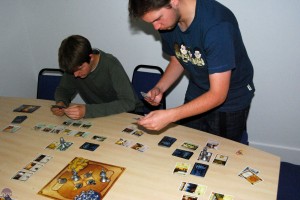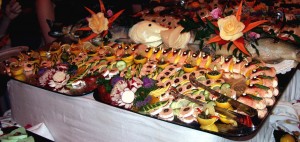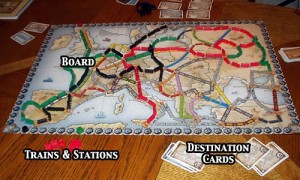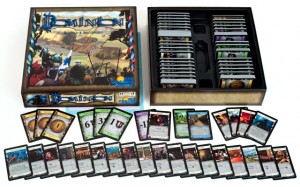 This is a tough review, because I simply didn’t like the Game of Thrones card game. It’s not my kind of game. However, I’d like to play it again at least once, because it has interesting strategy implications.
This is a tough review, because I simply didn’t like the Game of Thrones card game. It’s not my kind of game. However, I’d like to play it again at least once, because it has interesting strategy implications.
And that is both the positive and negative of the Game of Thrones card game. Imagine Magic: The Gathering with 50% more rules. It’s deep and complex. This can be good or bad, depending on your temperament.
Each player represents a faction, and gets a deck of cards to represent that. The deck include characters, locations, events, and various enhancements (weapon, armor, etc.).
The deck also includes seven special Plot cards. Those are set aside; more on those later.
Play does not proceed in any normal order. To begin, you set up a little board that contains six plastic tokens. Starting clockwise (but in a different order in later rounds), each player chooses one of the tokens. Each token confers a specific benefit; more on those later.
Each player then chooses and reveals a Plot card. This card confers its own special benefit or drawback, such as making certain cards easier or harder to field.
Plot cards also include an initiative value. The player with the highest initiative doesn’t go first, though! The player with the highest initiative chooses who goes first.
Each player in turn (proceeding clockwise) then gets money based on a money value printed on the Plot cards. Each card in the deck has a cost, and the player can only play as many cards as he can afford. He places the cards he can afford face-up in front of him, and they remain there until killed.
Characters and Locations are placed normally, while enhancements must go on a character.
Then, each player in turn can attack other players. But wait! There are three different kinds of attacks, each represented by a special icon. Some characters can only perform some of these attacks.

This is pretty much what we looked like (from this review)
Make sense so far? Just wait!
Getting back to those plastic tokens: Each one gives you a bonus (more gold, an extra few points of power when performing a certain attack, etc.), and some tokens prevent you from attacking a player holding another token. It’s different for each token. Of course.
And all this can be modified by certain cards in play. There are even cards that kill the enemy, even if you’re not performing a killing attack.
It blew my mind. Information overload, and I don’t know how much I’d enjoy it even after playing it a few times. So many things can affect your strategy that I feel I’d always be gasping for air.
But that’s just me. The game does provide a huge range of options and tactics, and is sure to appeal to gamers who relish that sort of complexity.








